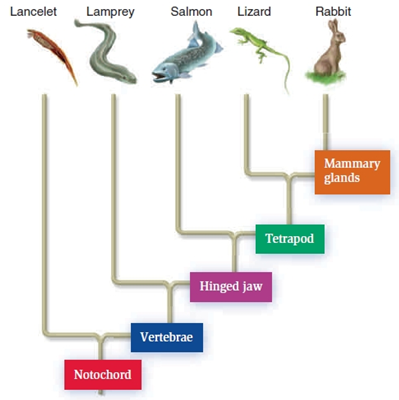Sediments that are formed from seawater as a result of a variety of chemical processes are called:
a. cosmogenous.
b. hydrogenous.
c. organic..
d. biogenous.
e. terrigenous.
B
You might also like to view...
In the cladogram shown, the animals across the top are a lancelet, lamprey, salmon, lizard, and rabbit (from left to right). If the salmon, lizard, and rabbit are an ingroup, which animals make up the outgroup, and which characteristics are synapomorphies of the ingroup?

A. Lamprey and lancelet; notochord and vertebrae
B. Lancelet only; notochord, vertebrae, hinged jaw, tetrapod, and mammary glands.
C. Lancelet and lamprey; hinged jaw.
D. Lancelet, lamprey and salmon; notochord, vertebrae, and a hinged jaw.
E. Lizard and rabbit; tetrapod and mammary glands.
The renal medulla contains the:a
renal pyramids. b. Bowman's capsules. c. distal convoluted tubules. d. glomeruli. e. proximal convoluted tubules
The point at which the number of births equals the number of deaths is called ________
Fill in the blank(s) with correct word
Several epidemic microbial diseases of earlier centuries incurred high death rates because they resulted in severe dehydration due to vomiting and diarrhea. Today they are usually not fatal because we have developed which of the following?
A) antiviral medications that are efficient and work well with most viruses B) intravenous feeding techniques C) medications to slow blood loss D) hydrating drinks with high concentrations of salts and glucose